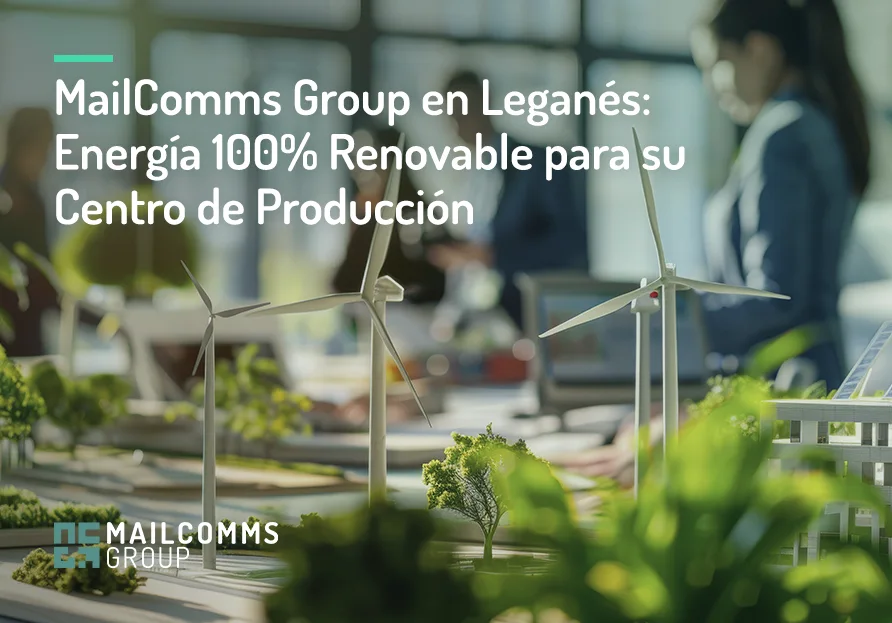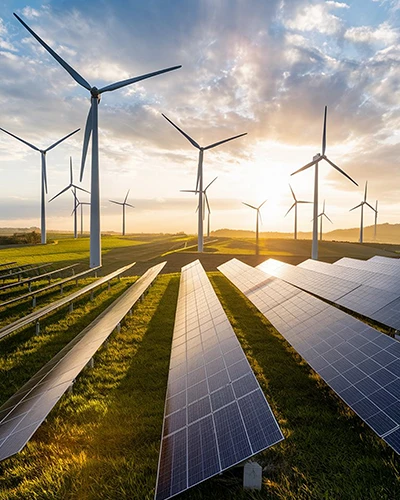
MailComms Group’s production center in Leganés (Madrid) will purchase all of its energy from renewable sources to carry out its activities. In these facilities, which consist of 7,500 m2, the company performs all its printing, enveloping, finishing, logistics and warehousing tasks with state-of-the-art (energy-efficient) machinery and the strictest security measures in terms of information security and privacy, among other aspects.
Certificate of Guarantees of Origin (GoO)
This decision will be supported by a GdO (Guarantees of Origin) certificate that will ensure the green origin of the electricity used at the production site. A GoO is an accreditation that the energy consumed by a company has been produced from non-polluting sources partially or totally, and indicates the percentage (either 100% or less) of sustainable origin in the energy mix.
The GdO are documents that evidence the certification of green energy purchase by CUPS (Universal Supply Point Code). This is a further guarantee of electricity consumption from renewable sources. To obtain this accreditation (certificate of redemption by CUPS), the following steps must be followed:
- Request: the owner of the installation or the marketer must request the redemption of the guarantees of origin (GdOs) corresponding to the CUPS of the customers to whom electricity has been supplied.
- Review: the regulatory entity supervises the issuance of certificates. In Spain, the Comisión Nacional de los Mercados y la Competencia.
- Issuance: The certificate certifying that the energy consumed comes from renewable sources is issued. The certificate can be self-generated automatically by the customer, as long as the CUPS meets the requirements, through the CNMC website.
Environmental benefits
Renewable energies are those that come from natural sources, which are continuously regenerated and practically inexhaustible. Although there are many types, the most common are solar, wind, hydro, biomass (derived from the cremation of organic matter) and geothermal (which uses heat from the subsoil). These energy sources are more sustainable and produce far fewer polluting emissions than those based on fossil fuels.
 This type of energy offers many advantages in terms of environmental protection. Some of the most outstanding are:
This type of energy offers many advantages in terms of environmental protection. Some of the most outstanding are:
- Reduction of greenhouse gas emissions.
- Inexhaustibility. Renewable sources, such as the sun and wind, are practically inexhaustible, guaranteeing a continuous supply in the long term.
- Energy diversification.
- Economic development, through the generation of employment and the promotion of technological and industrial development.
- Long-term cost reduction, both operational and maintenance costs.
- Health benefits from reduced air and water pollution.
Benefits for companies
Companies that choose to use green energies also obtain significant benefits, such as stable energy costs (the long-term prices of these energies tend to vary less), security of supply, compliance with regulations and certifications, improved brand image and a reduced carbon footprint.
Green energies are considered zero-emission because their generation does not produce greenhouse gases or other pollutants that contribute to climate change. This is because of the sources from which they come, the environmental efficiency of their life cycle (the manufacture and installation of the equipment may generate emissions, but these are minimal compared to those avoided during their useful life) and the offsetting of emissions. In other words, in some cases, companies obtain renewable energy certificates (GoO) that guarantee that an equivalent amount of green electricity has been added to the power grid, thus offsetting the emissions from their energy consumption.
Renewable energies and the UN SDGs
While central to achieving several of the UN Sustainable Development Goals, renewable energy takes on particular relevance in SDG 7, which seeks to ensure access to affordable, secure, sustainable and modern energy for all people.
The United Nations has set out to achieve universal energy access by 2030, and renewables are essential to achieve this, especially in rural areas or areas with limited traditional infrastructure. Emissions reduction also plays an important role in SDG 13 (Climate action), technology and employment development in SDG 8 (Decent work and economic growth) and innovation and sustainability contributes to SDG 9 (Industry, innovation and infrastructure). SDG 3 (Health and well-being) also benefits.

